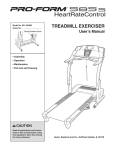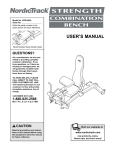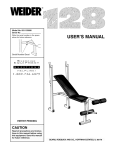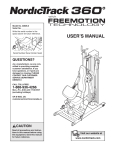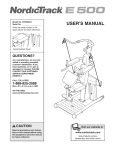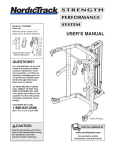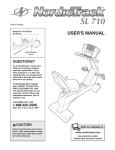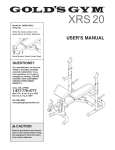Download USER`S MANUAL - Icon Heath & Fitness
Transcript
Ordering Replacement Parts If you encounter any difficulties with this product, or if you need to order replacement parts, call the ICON Health & Fitness Ltd. office, or write: ICON Health & Fitness Ltd. Unit 4 Revie Road Industrial Estate Revie Road Beeston Leeds, LS118JG UK Model No. WEEVBE33110 Serial No. Write the serial number in the space above for reference. Tel: 08457 089 009 Outside the UK: 0 (044) 113 387 7133 Fax: 0 (044) 113 387 7125 USER’S MANUAL When ordering parts, please be prepared to give the following information: Serial Number Decal (under seat) • The MODEL NUMBER OF THE PRODUCT (WEEVBE33110) QUESTIONS? • The NAME OF THE PRODUCT (WEIDER® PRO 440) • The SERIAL NUMBER OF THE PRODUCT (see the front cover of this manual) • The KEY NUMBER AND DESCRIPTION OF THE PART(S) (see the Part List and the Exploded Drawing at the centre of this manual) As a manufacturer, we are committed to providing complete customer satisfaction. If you have questions, or if there are missing or damaged parts, please call: 08457 089 009 Or write: ICON Health & Fitness Ltd. Unit 4 Revie Road Industrial Estate Revie Road Beeston Leeds, LS118JG UK email: [email protected] CAUTION Read all precautions and instructions in this manual before using this equipment. Save this manual for future reference. Part No. 175463 R0404A Printed in China © 2004 ICON IP, Inc. Table of Contents EXERCISE MONDAY WEIGHT SETS REPS WEIGHT SETS REPS WEIGHT SETS REPS Date: / Warning Decal Placement . . . . . . . . . . . . . . . . . . . . . . . . . . . . . . . . . . . . . . . . . . . . . . . . . . . . . . . . . . . . . . . . . . . 2 Important Precautions . . . . . . . . . . . . . . . . . . . . . . . . . . . . . . . . . . . . . . . . . . . . . . . . . . . . . . . . . . . . . . . . . . . . . . 3 Before You Begin . . . . . . . . . . . . . . . . . . . . . . . . . . . . . . . . . . . . . . . . . . . . . . . . . . . . . . . . . . . . . . . . . . . . . . . . . . 4 Part Identification Chart . . . . . . . . . . . . . . . . . . . . . . . . . . . . . . . . . . . . . . . . . . . . . . . . . . . . . . . . . . . . . . . . . . . . . 5 Assembly . . . . . . . . . . . . . . . . . . . . . . . . . . . . . . . . . . . . . . . . . . . . . . . . . . . . . . . . . . . . . . . . . . . . . . . . . . . . . . . . 6 Adjusting the Weight Bench . . . . . . . . . . . . . . . . . . . . . . . . . . . . . . . . . . . . . . . . . . . . . . . . . . . . . . . . . . . . . . . . . 10 Exercise Guidelines . . . . . . . . . . . . . . . . . . . . . . . . . . . . . . . . . . . . . . . . . . . . . . . . . . . . . . . . . . . . . . . . . . . . . . . 13 Ordering Replacement Parts . . . . . . . . . . . . . . . . . . . . . . . . . . . . . . . . . . . . . . . . . . . . . . . . . . . . . . . . . Back Cover / Note: A Part List and an Exploded Drawing are attached in the centre of this manual. Remove the Part List and Exploded Drawing before beginning assembly. AEROBIC EXERCISE TUESDAY Warning Decal Placement Date: / The decals shown below have been placed on the weight bench. If a decal is missing, or if it is not legible, please call our Customer Service Department (see the front cover), to order a free replacement decal. Apply the replacement decal in the location shown. / WEDNESDAY EXERCISE Date: / / Keep hands and fingers clear of this area. THURSDAY AEROBIC EXERCISE Date: / / EXERCISE FRIDAY Date: / WEIDER is a registered trademark of ICON IP, Inc. 2 / Make photocopies of this page for scheduling and recording your workouts. 15 Rest for a short period of time after each set. The ideal resting periods are: • Rest for three minutes after each set for a muscle building workout. • Rest for one minute after each set for a toning workout. • Rest for 30 seconds after each set for a weight loss workout. Plan to spend the first couple of weeks familiarising yourself with the equipment and learning the proper form for each exercise. slowly as you stretch and do not bounce. Ease into each stretch gradually and go only as far as you can without strain. Stretching at the end of each workout is an effective way to increase flexibility. Important Precautions STAYING MOTIVATED To reduce the risk of serious injury, read the following important precautions before using the weight bench. WARNING: For motivation, keep a record of each workout. The chart on page 15 of this manual can be photocopied and used to schedule and record your workouts. List the date, the exercises performed, the resistance used, and the numbers of sets and repetitions completed. Record your weight and key body measurements at the end of every month. Remember, the key to achieving the greatest results is to make exercise a regular and enjoyable part of your everyday life. COOLING DOWN End each workout with 5 to 10 minutes of stretching. Include stretches for both your arms and legs. Move MUSCLE CHART A. B. C. D. E. F. G. H. I. J. K. L. M. N. O. P. Q. R. S. T. U. V. W. X. Sternomastoid (neck) Pectoralis Major (chest) Biceps (front of arm) Obliques (waist) Brachioradials (forearm) Hip Flexors (upper thigh) Abductor (outer thigh) Quadriceps (front of thigh) Sartorius (front of thigh) Tibialis Anterior (front of calf) Soleus (front of calf) Anterior Deltoid (shoulder) Rectus Abdominus (stomach) Adductor (inner thigh) Trapezius (upper back) Rhomboideus (upper back) Posterior Deltoid (shoulder) Triceps (back of arm) Latissimus Dorsi (mid back) Spinae Erectors (lower back) Gluteus Medius (hip) Gluteus Maximus (buttocks) Hamstring (back of leg) Gastrocnemius (back of calf) O O AA P P L L BB Q Q CC R R DD S S EE T T F F G G M M 12. Always place 23 kg (50 lbs.) on the leg lever to balance the bench when performing squat exercises (see page 12). 2. It is the responsibility of the owner to ensure that all users of the weight bench are adequately informed of all precautions. 13. Always fold the backrest out of the way when performing squat exercises (see page 11). Do not sit on the seat when the backrest is folded. 3. The weight bench is intended for home use only. Do not use the weight bench in any commercial, rental, or institutional setting. 14. Do not stand with your back to the weight bench when performing squat exercises (see page 11). You should be able to see the weight rests while exercising so that you can safely return the barbell to the weight rests when you finish the exercise. 4. Use the weight bench only on a level surface. Cover the floor beneath the weight bench to protect the floor. 15. When using the backrest, make sure the adjustment tube is fully inserted into the adjustment brackets on the uprights. 5. Inspect and tighten all parts each time you use the weight bench. Replace any worn parts immediately. 16. Always remove the curl post from the front leg before performing leg curl or leg extension exercises with the leg lever (see page 12). 6. Keep children under the age of 12 and pets away from the weight bench at all times. 7. Keep hands and feet away from moving parts. U U 17. Always set both weight rests at the same height. The adjustment knobs must be inserted through both the uprights and the weight rests and firmly tightened into the welded nuts. Never tighten the adjustment knobs into the uprights and then set the weight rests in the uprights on top of the adjustment knobs. 8. Always wear athletic shoes for foot protection while exercising. NN HH V V II W W JJ X X KK 1. Read all instructions in this manual before using the weight bench. Use the weight bench only as described in this manual. 9. Do not use a barbell (not included) longer than 1.8 m (6 ft.) with the weight bench. 10. When you are using a barbell (not included), always make sure there is an equal amount of weight on each side. 18. Always exercise with a partner. When you are performing bench press exercises, squat exercises or toe raise exercises, your partner should stand behind you to catch the barbell if you cannot complete a repetition. 11. The weight bench is designed to support a maximum of 208 kg (460 lbs.), including the user, a barbell and weights. Do not place more than 95 kg (210 lbs.), including a barbell and weights on the weight rests. Do not place more than 59 kg (130 lbs.) on the leg lever for normal use. 19. If you feel pain or dizziness at any time while exercising, stop immediately and begin cooling down. WARNING: Before beginning this or any exercise program, consult your physician. This is especially important for persons over the age of 35 or persons with pre-existing health problems. Read all instructions before using. ICON assumes no responsibility for personal injury or property damage sustained by or through the use of this product. 14 3 Before You Begin Exercise Guidelines tions, please call our Customer Service Department at 08457 089 009. To help us assist you, please note the product model number and serial number before calling. The model number is WEEVBE33110. The serial number can be found on a decal attached to the weight bench (see the front cover of this manual). Thank you for selecting the versatile WEIDER® PRO 440 weight bench. The weight bench is designed to help you develop every major muscle group of the body. Whether your goal is to tone your body, build dramatic muscle size and strength, or improve your cardiovascular system, the weight bench will help you to achieve the results you want. Before reading further, please review the drawing below and familiarise yourself with the parts that are labelled. For your benefit, read this manual carefully before using the weight bench. If you have additional ques- Weight Rests THE FOUR BASIC TYPES OF WORKOUTS PERSONALISING YOUR EXERCISE PROGRAM Muscle Building To increase the size and strength of your muscles, push them close to their maximum capacity. Your muscles will continually adapt and grow as you progressively increase the intensity of your exercise. You can adjust the intensity level of an individual exercise in two ways: • by changing the amount of resistance used • by changing the number of repetitions or sets performed. (A “repetition” is one complete cycle of an exercise, such as one sit-up. A “set” is a series of repetitions.) Determining the exact length of time for each workout, as well as the number of repetitions or sets completed, is an individual matter. It is important to avoid overdoing it during the first few months of your exercise program. You should progress at your own pace and be sensitive to your body’s signals. If you experience pain or dizziness at any time whilst exercising, stop immediately and begin cooling down. Find out what is wrong before continuing. Remember that adequate rest and a proper diet are important factors in any exercise program. WARMING UP Curl Pad Adjustment Knob Backrest Adjustment Tube Upright Leg Lever Seat Weight Tube Anchor Hole* *Note: Use the anchor holes to secure the weight bench in a fixed position, if desired. The proper amount of resistance for each exercise depends upon the individual user. You must gauge your limits and select the amount of resistance that is right for you. Begin with 3 sets of 8 repetitions for each exercise you perform. Rest for 3 minutes after each set. When you can complete 3 sets of 12 repetitions without difficulty, increase the amount of resistance. Begin each workout with 5 to 10 minutes of stretching and light exercise to warm up. Warming up prepares your body for more strenuous exercise by increasing circulation, raising your body temperature and delivering more oxygen to your muscles. WORKING OUT Toning You can tone your muscles by pushing them to a moderate percentage of their capacity. Select a moderate amount of resistance and increase the number of repetitions in each set. Complete as many sets of 15 to 20 repetitions as possible without discomfort. Rest for 1 minute after each set. Work your muscles by completing more sets rather than by using high amounts of resistance. Each workout should include 6 to 10 different exercises. Select exercises for every major muscle group, emphasising areas that you want to develop most. To give balance and variety to your workouts, vary the exercises from session to session. Schedule your workouts for the time of day when your energy level is the highest. Each workout should be followed by at least one day of rest. Once you find the schedule that is right for you, stick with it. Weight Loss To lose weight, use a low amount of resistance and increase the number of repetitions in each set. Exercise for 20 to 30 minutes, resting for a maximum of 30 seconds between sets. EXERCISE FORM Maintaining proper form is an essential part of an effective exercise program. This requires moving through the full range of motion for each exercise, and moving only the appropriate parts of the body. Exercising in an uncontrolled manner will leave you feeling exhausted. On the exercise guide accompanying this manual you will find photographs showing the correct form for several exercises, and a list of the muscles affected. Refer to the muscle chart on the next page to find the names of the muscles. Cross Training Cross training is an efficient way to get a complete and well-balanced fitness program. An example of a balanced program is: • Plan strength training workouts on Monday, Wednesday, and Friday. • Plan 20 to 30 minutes of aerobic exercise, such as running on a treadmill or riding on an elliptical or exercise bike, on Tuesday and Thursday. • Rest from both strength training and aerobic exercise for at least one full day each week to give your body time to regenerate. The repetitions in each set should be performed smoothly and without pausing. The exertion stage of each repetition should last about half as long as the return stage. Proper breathing is important. Exhale during the exertion stage of each repetition and inhale during the return stroke. Never hold your breath. The combination of strength training and aerobic exercise will reshape and strengthen your body, plus develop your heart and lungs. 4 13 ATTACHING WEIGHTS TO THE LEG LEVER Part Identification Chart To use the Leg Lever (3), slide the desired amount of weight (not included) onto the weight tube. 3 This chart is provided to help you identify the small parts used in assembly. The number in parentheses below each part refers to the key number of the part. Important: Some parts may have been pre-assembled for shipping purposes. If you cannot find a part in the parts bags, check to see if it has been pre-assembled. WARNING: Do not place more than 59 kg (130 lbs.) on the Leg Lever (3). M10 x 73mm Bolt (41) LOCKING THE LEG LEVER M10 Washer (37) Some exercises, such as sit-ups, can be performed more comfortably with the Leg Lever (3) locked. To lock the Leg Lever, turn the Leg lever Lock (2) until it engages the Short Pad Tube (17). M8 x 67mm Bolt (42) M10 x 175mm Bolt (43) 2 3 17 ATTACHING THE CURL POST For some exercises, the Curl Post (10) must be attached to the weight bench. Remove the 45mm Square Inner Cap (27) and insert the Curl Post into the Front Leg (4). Slide the M8 Adjustment Knob (26) through the Front Leg and the Curl Post, and turn it clockwise until it is tight. Make sure that you fully tighten the Adjustment Knob. When the Curl Post (10) is not in use, store the Curl Post away from the weight bench. Insert the 45mm Square Inner Cap (27) halfway into the top of the Front Leg (4). 10 M8 Washer (21) M10 x 65mm Bolt (15) M8 x 62mm Bolt (48) M6 Washer (36) M8 x 60mm Bolt (38) 26 M8 Nylon Locknut (40) 27 M8 x 55mm Carriage Bolt (47) M10 Nylon Locknut (49) 4 M6 x 40mm Bolt (44) M8 x 16mm Bolt (39) 12 M6 x 16mm Bolt (45) 5 10mm Plastic Bushing (35) ADJUSTING THE WEIGHT RESTS Assembly 11 To change the height of the Weight Rests (11), first remove your barbell (not shown). • Place all parts in a cleared area and remove the packing materials. Do not dispose of the packing materials until assembly is completed. Make Things Easier for Yourself Everything in this manual is designed to ensure that the weight bench can be assembled successfully by anyone. However, it is important to recognise that the weight bench has many small parts, and that the assembly process will take time. Most people find that by setting aside plenty of time, and by deciding to make the task enjoyable, assembly will go smoothly. The following tools (not included) are required for assembly: • Two adjustable spanners • One rubber mallet • One standard screwdriver • One phillips screwdriver • Lubricant, such as grease or petroleum jelly, and soapy water. • Tighten all parts as you assemble them, unless instructed to do otherwise. While holding a Weight Rest (11) with one hand, remove the M10 Adjustment Knob (25) from the Upright (8 or 9). Move the Weight Rest to the desired position. Insert the Adjustment Knob through the Upright and the Weight Rest, and turn it clockwise until it is tight. Adjust the other Weight Rest in the same manner. Make sure that you fully tighten the Adjustment Knobs. 8 25 WARNING: • Assembly requires two people. • As you assemble the weight bench, make sure all parts are oriented as shown in the drawings. 11 Always set both Weight Rests (11) at the same height. The M10 Adjustment Knobs (25) must be inserted through the Uprights (8, 9) and the Weight Rests (11). Never tighten the Adjustment Knobs into the Uprights and then set the Weight Rests in the Uprights on top of the Adjustment Knobs. 25 Assembly will be more convenient if you have the following tools: A socket set, a set of open-end or closed-end spanners or a set of ratchet spanners. • For help identifying small parts, use the Part Identification Chart on page 5. 1. Before assembling this product, make sure you have read and understand the information in the box above. 1 39 ADJUSTING THE WEIGHT BENCH FOR SQUAT EXERCISES 5 21 50 Insert a 1 3/4” Slotted Square Inner Cap (50) into the Bench Frame (5). Attach the Bench Frame (5) to the bracket on the Front Leg (4) with three M8 x 16mm Bolts (39) and three M8 Washers (21). Do not fully tighten the Bolts. 9 21 4 To perform squat or toe raise exercises, fold the Backrest (23) to the upright position as described on page 10. Remove the Adjustment Tube (12). Turn the Weight Rests (11) around, as shown, and adjust them to the highest setting (see ADJUSTING THE WEIGHT RESTS, above). 39 11 11 39 WARNING: Always place 23 kg (50 lbs.) on the leg lever to balance the bench when performing squat exercises. 2. Identify the Left Upright (8) by the location of the welded nut. 2 Welded Nut Press a 2” Square Inner Cap (29) into the lower end of the Left Upright (8). Press a 45mm Square Inner Cap (27) into an Upright Stabiliser (28). Attach the Left Base (6) and the Upright Stabiliser (28) to the Left Upright (8) with two M8 x 67mm Bolts (42) and two M8 Nylon Locknuts (40). Do not tighten the Nylon Locknuts yet. Repeat this step with the Right Upright (not shown) and the Right Base (not shown). 8 27 Always fold the Backrest (23) out of the way when performing squat exercises. 23 12 Do not stand with your back to the weight bench when performing squat exercises. You should be able to see the weight rests while exercising so that you can safely return the barbell (not included) when you finish the exercise. 28 40 6 6 42 25 29 11 Adjusting the Weight Bench This section explains how to adjust the weight bench. See the Exercise Guidelines on page 13 for important information on how to get the most benefit from your exercise program. Also, refer to the accompanying exercise guide to see the correct form for each exercise. Inspect and tighten all parts each time you use the weight bench. Replace any worn parts immediately. The weight bench can be cleaned with a damp cloth and a mild, non-abrasive detergent. Do not use solvents. 3. Attach the Bench Frame (5) to the Left and Right Bases (6, 7) with two M8 x 55mm Carriage Bolts (47) and two M8 Nylon Locknuts (40). Do not tighten the Nylon Locknuts yet. 3 5 Secure the Bench Frame (5) to the Left and Right Bases (6, 7) with two M8 x 62mm Bolts (48) and two M8 Nylon Locknuts (40). 40 48 7 6 FOLDING THE BACKREST 47 40 To perform squat exercises, the Backrest (23) must be folded to the upright position. To fold the Backrest, lift and pull it forward as far as it will go. It will be held in place by its own weight. 4. Press an Outer Upright Bushing (46) onto the top of each Upright (8, 9). 23 Slide a Weight Rest (11) into the Right Upright (9). Insert an M10 Adjustment Knob (25) into the hole in the Upright and an adjustment hole in the Weight Rest. Tighten the Knob into the welded nut. WARNING: Always fold the Backrest (23) out of the way when performing squat exercises. Do not sit on the seat when the Backrest is folded. 4 11 11 46 Insert the other Weight Rest (11) into the Left Upright (8) in the same manner. 8 Welded Nut 25 Note: Both Weight Rests (11) must be set at the same height. ADJUSTING THE BACKREST The Backrest (23) can be set at three different positions: level, declined, or inclined. To change the position of the Backrest, move the Adjustment Tube (12) to a different set of adjustment brackets in the Uprights. Note: When moving the Adjustment Tube (12), make sure that the pins are seated in the slots in the adjustment brackets. 9 5. Press a 1 1/4” Square Inner Cap (34) into each end of the Adjustment Tube (12). 5 34 Insert the Adjustment Tube (12) into a set of adjustment brackets on the Uprights (8, 9). 23 Adjustment Bracket 12 Make sure that the pins on the Adjustment Tube (12) are fully inserted into the slots in the adjustment brackets. 12 34 8 Tighten the Nylon Locknuts (40) used in steps 2 and 3. ADJUSTING THE LEG SUPPORT PADS Pull a Foam Pad (18) off the Long Pad Tube (16). Remove the Pad Tube from the Front Leg (4) and reinsert it into another hole. Replace the Foam Pad. 9 Pin 6. Orient the Backrest Tubes (13, 14) as shown. Note: The welded tubes must extend towards the centre. 6 32 13 Insert a 1” Square Inner Cap (32) into the open end of each Backrest Tube (13, 14). Insert a 10mm Plastic Bushing (35) into each end of the welded tubes on the Backrest Tubes. 4 16 18 Welded Tubes 35 10 7 14 7. Identify the Left and Right Seat Brackets (1, 19); orient them as shown. 10. Press a 1 1/2” Square Inner Cap (33) into each end of the Leg Lever (3). 7 Lubricate an M10 x 175mm Bolt (43). Slide the Bolt through an M10 Washer (37), the Left Backrest Tube (13), the indicated hole in the Left Seat Bracket (1), and a Plastic Spacer (20). Next, insert the Bolt through the Bench Frame (5). Slide another Plastic Spacer, the Right Seat Bracket (19), the Right Backrest Tube (14), and another M10 Washer onto the Bolt. Secure the Bolt with an M10 Nylon Locknut (49). 3 Press a 1” Round Inner Cap (30) into each end of the weight tube on the Leg Lever (3). Lubricate 33 13 30 43 37 14 15 30 20 1 Weight Tube 19 Do not overtighten the Nylon Locknut (49). You must be able to freely pivot the Backrest Tubes (13, 14) and Seat Brackets (1, 19). 49 37 Secure the Seat Brackets (1, 19) to the Bench Frame (5) with an M10 x 65mm Bolt (15) and an M10 Nylon Locknut (49). Do not tighten the Nylon Locknut until step 9 is completed. 8. Attach the Backrest (23) to the Backrest Tubes (13, 14) with four M6 Washers (36) and four M6 x 40mm Bolts (44). Make sure that the Backrest is oriented as shown. 10 11. Lubricate an M10 x 73mm Bolt (41). Attach the Leg Lever (3) to the bracket on the Front Leg (4) with the Bolt and an M10 Nylon Locknut (49). 11 49 3 5 Attach the Leg Lever Lock (2) to the Front Leg (4) with an M8 x 60mm Bolt (38), an M8 Washer (21), and an M8 Nylon Locknut (40). Do not overtighten the Nylon Locknut. The Leg Lever Lock must be easy to turn. 49 41 40 Lubricate 4 21 8 12. Press two 3/4” Round Inner Caps (31) into each of the three Pad Tubes (16, 17). 23 12 2 38 16 18 3 31 Insert a Short Pad Tube (17) into each of the holes in the Leg Lever (3). 31 14 Insert the Long Pad Tube (16) into the upper set of holes in the Front Leg (4). 13 17 36 Slide a Foam Pad (18) onto each side of each Pad Tube (16, 17). 44 31 18 17 13. Attach the Curl Pad (24) to the Curl Post (10) with two M6 x 16mm Bolts (45). 9 31 4 13 1 22 18 18 44 9. Attach the Seat (22) to the Seat Brackets (1, 19) with four M6 x 16mm Bolts (45). Note: Make sure the narrow end of the Seat is pointing towards the Backrest (23). 33 24 Tighten the M10 x 65mm Bolt (15) and the M10 Nylon Locknut (49) used in step 7. 23 45 19 5 45 8 45 14. Make sure all parts are properly tightened before you use the weight bench. The use of all remaining parts will be explained in Adjusting the Weight Bench, starting on page 10. 9 10 Part List—Model No. WEEVBE33110 Qty. 1 2 3 4 5 6 7 8 9 10 11 12 13 14 15 16 17 18 19 20 21 22 23 24 25 26 1 1 1 1 1 1 1 1 1 1 2 1 1 1 1 1 2 6 1 2 4 1 1 1 2 1 Description Left Seat Bracket Leg Lever Lock Leg Lever Front Leg Bench Frame Left Base Right Base Left Upright Right Upright Curl Post Weight Rest Adjustment Tube Left Backrest Tube Right Backrest Tube M10 x 65mm Bolt Long Pad Tube Short Pad Tube Foam Pad Right Seat Bracket Plastic Spacer M8 Washer Seat Backrest Curl Pad M10 Adjustment Knob M8 Adjustment Knob Key No. Qty. 27 28 29 30 31 32 33 34 35 36 37 38 39 40 41 42 43 44 45 46 47 48 49 50 # # 3 2 2 2 6 2 2 2 4 4 2 1 3 9 1 4 1 4 6 2 2 2 3 1 1 1 Description 45mm Square Inner Cap Upright Stabiliser 2” Square Inner Cap 1” Round Inner Cap 3/4” Round Inner Cap 1” Square Inner Cap 1 1/2” Square Inner Cap 1 1/4” Square Inner Cap 10mm Plastic Bushing M6 Washer M10 Washer M8 x 60mm Bolt M8 x 16mm Bolt M8 Nylon Locknut M10 x 73mm Bolt M8 x 67mm Bolt M10 x 175mm Bolt M6 x 40mm Bolt M6 x 16mm Bolt Outer Upright Bushing M8 x 55mm Carriage Bolt M8 x 62mm Bolt M10 Nylon Locknut 1 3/4” Slotted Square Inner Cap User’s Manual Exercise Guide Note: “#” indicates a non-illustrated part. Specifications are subject to change without notice. See the back cover of the user’s manual for information about ordering replacement parts. REMOVE THIS PART LIST/EXPLODED DRAWING FROM THE MANUAL SAVE THIS PART LIST/EXPLODED DRAWING FOR FUTURE REFERENCE 81 Key No. R0404A 23 Exploded Drawing—Model No. WEEVBE33110 R0404A 32 34 22 13 37 20 43 12 36 14 35 34 11 44 15 19 45 1 36 46 44 24 49 45 37 49 11 25 50 45 18 5 10 31 45 39 42 46 27 48 16 21 27 8 40 39 26 25 21 31 39 49 21 27 28 40 40 9 29 18 42 3 31 31 40 17 33 30 30 4 18 31 6 41 21 18 40 28 7 2 38 18 29 33 47










